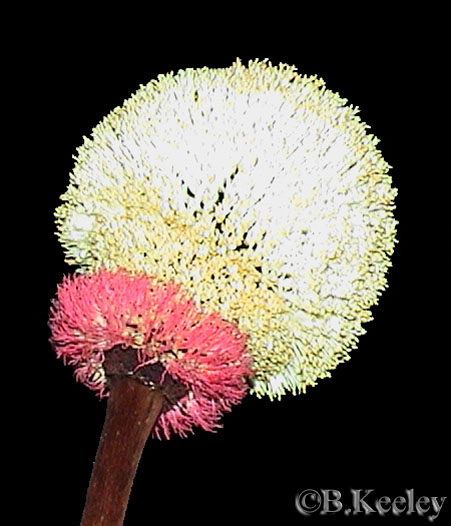Central French Guiana
Nancy B. Simmons & Robert S. Voss
Department of Mammalogy
American Museum of Natural History
simmons@amnh.org and voss@amnh.org
and
Scott A. Mori
Institute of Systematic Botany
The New York Botanical Garden
smori@nybg.org
Central French Guiana may be home to as many as eight bat species that are obligate or predominant nectarivores (Appendix I), and an additional 29 bat species that are known or suspected opportunistic nectarivores (Appendix II).
There are 1,918 species of flowering plants described in the flora of central French Guiana (Mori et al., 1997, 2002). Bats play an important role in pollination as well as in the dispersal of flowering plants (Gardner, 1977). In central French Guiana, the extent of bat pollination has not yet been determined. Many of the plant species occurring there are known to be bat-pollinated in other parts of their range, a few of which are the zygomorphic, green-petalled Lecythis poiteaui (Lecythidaceae); the long-stamened Caryocar glabrum subsp. glabrum; the bottle-brush-flowered Parkia decussata; and the tubular, light colored flowers of Markea camponoti. Although Neotropical bat flowers are diverse in morphology, most bat-pollinated species possess some combination of nocturnal flowers, inflorescences produced free from the foliage thereby providing easier access to the flowers by bats (Pijl, 1957), a musky aroma dominated by sulphur-containing compounds (Knudsen & Tollsten, 1995), and a relatively dilute nectar rich in hexose sugar (Baker et al., 1998).
 Parkia decussata Parkia decussata |
A long-term goal of our bat/plant research in central French Guiana is to provide information about what plants are pollinated by what bats and what bats are pollinators of plants. Preliminary lists of obligate (Appendix I) and opportunistic (Appendix II) nectarivores have already been prepared based on a comparison of the bats known to occur at Paracou (Simmons & Voss, 1998) and Arataye (Voss & Emmons, 1996), French Guiana with information about bat dietary preferences in Gardner (1977). A list of plants known to be pollinated by bats is under preparation.
Baker, H. G., I. Baker & S. A. Hodges. 1998. Sugar composition of nectars and fruits consumed by birds and bats in the tropics and subtropics. Biotropica 30(4): 559-586.
Gardner, A. L. 1977. Feeding habits. Pages 293-350 in R. J. Baker, J. K. Jones & D. C. Carter (eds.), Biology of bats of the New World family Phyllostomatidae. Part II. Spec. Publ. Mus. Texas Tech. Univ., Lubbock.
Knudsen, J. T. & L. Tollsten. 1995. Floral scent in bat-pollinated plants: a case of convergent evolution. Bot. J. Linn. Soc. 119: 45-57.
Mori, S. A., G. Cremers, C. Gracie, J.-J. de Granville, M. Hoff & J. D. Mitchell. 1997. Guide to the vascular plants of central French Guiana. Part 1. Pteridophytes, gymnosperms, and monocotyledons. Mem. New York Bot. Gard. 76(1): 1-422.
Mori, S. A., G. Cremers, C. Gracie, J.-J. de Granville, S. V. Heald, M. Hoff & J. D. Mitchell. 2002. Guide to the vascular plants of central French Guiana . Part 2. Dicotyledons. Mem. New York Bot. Gard. 76(2): 1-776.
Pijl, L. van der. 1957. The dispersal of plants by bats (Cheiropterochory). Acta Bot. Nederlandica 6: 291-315.
Simmons, N. B. & R. S. Voss. 1998. The mammals of Paracou, French Guiana: A Neotropical lowland rainforest fauna. Part 1. Bats. Bull. Amer. Mus. Nat. Hist. 237: 1-219.
Voss, R. S. & L. H. Emmons. 1996. Mammalian diversity in Neotropical lowland rainforests: a preliminary assessment. Bull. Amer. Mus. Nat. Hist. 230: 1-115.
Go to TOP
Go to Appendix
1 - Obligate Nectarivorous Bats
Go to Appendix
2 - Opportunistic Nectarivorous Bats
Go to Bats
as Dispersers
Last updated: April 2007. For problems or questions, please contact: tlobova@odu.edu or smori@nybg.org